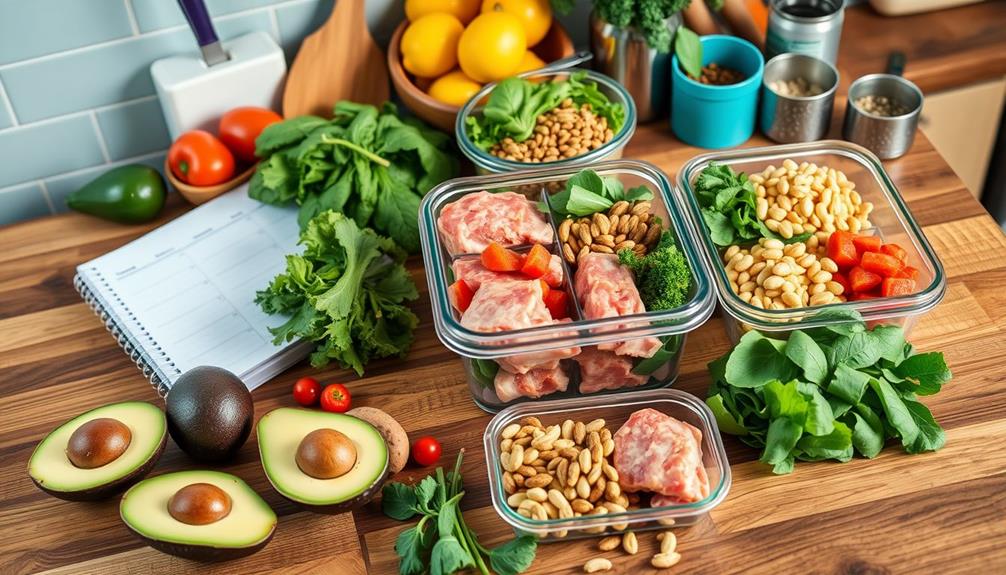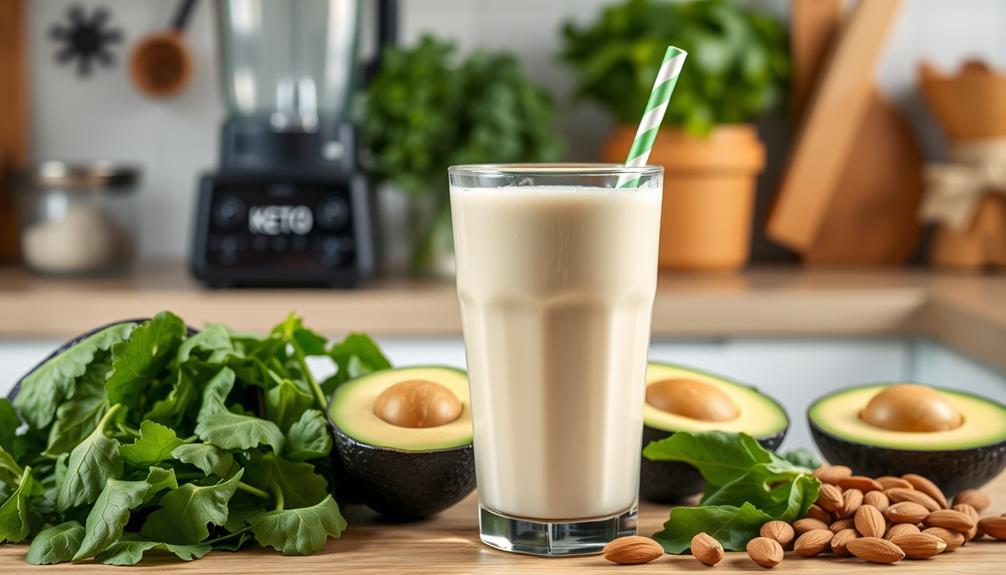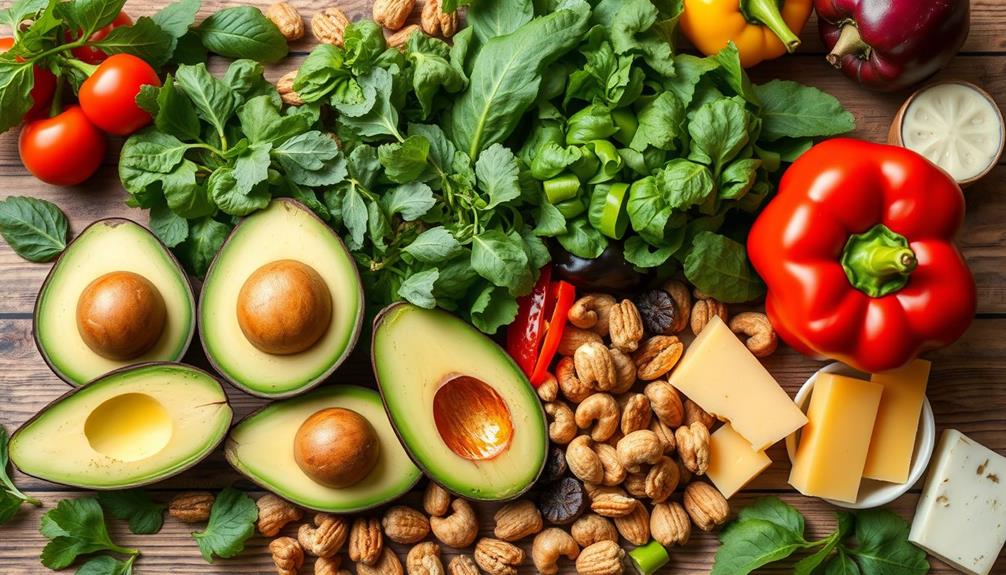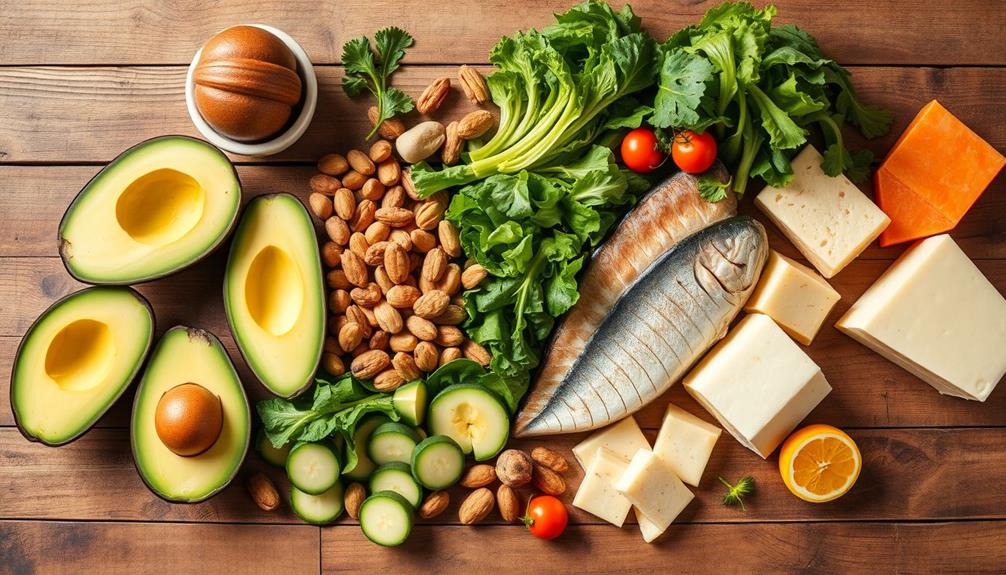To eat a keto diet, start by cutting your carb intake to about 20-50 grams per day while boosting healthy fats. Fill your plate with avocados, olive oil, and full-fat dairy, alongside proteins like meat, fish, and eggs. Incorporate low-carb veggies like spinach and cauliflower to get essential nutrients. Plan your meals ahead and batch cook to save time and stay on track. Also, keep hydrated to manage potential side effects like fatigue. This approach will help you maintain a sustainable keto lifestyle, and if you're curious about more tips and tricks, you'll find valuable insights ahead. For some additional benefits, consider incorporating intermittent fasting on a keto diet. This can help with weight loss and improve insulin sensitivity. Start by gradually increasing the fasting window, and be sure to stay hydrated during fasting periods. Fasting on keto diet can be a powerful tool to enhance the benefits of ketosis and promote overall health and wellbeing.
Key Takeaways
- Limit carbohydrate intake to 20-50 grams per day to promote ketosis and shift your body's energy source from carbs to fats.
- Focus on consuming healthy fats (70% of daily calories), moderate protein (20%), and low-carb vegetables (10%) for balanced nutrition.
- Plan meals by creating a grocery list of keto-friendly foods, including healthy fats, animal proteins, and low-carb vegetables.
- Stay hydrated and boost salt intake to manage potential side effects like "keto flu" during the initial transition phase.
- Monitor your progress and symptoms using food diaries or apps to ensure adherence to the ketogenic diet effectively.
Understanding the Ketogenic Diet

The ketogenic diet is a low-carb, high-fat eating plan that can dramatically change how your body uses energy. By drastically reducing your carbohydrates per day to about 20-50 grams, you encourage your body to enter a metabolic state known as ketosis. In this state, your body shifts from burning carbohydrates to burning fats for fuel, utilizing ketones produced in the liver.
Additionally, incorporating a variety of nutrient-rich foods can help mitigate some of the initial side effects of the diet.
This high fat diet emphasizes healthy fats, which typically make up about 70% of your daily caloric intake. You'll be focusing on foods like meat, eggs, dairy, and low-carb vegetables while avoiding sugary foods, grains, most fruits, and starchy vegetables.
Adopting a ketogenic diet can lead to significant weight loss and improved insulin sensitivity, with studies showing an average loss of 2 pounds more than those on traditional low fat diets.
However, be prepared for some initial side effects commonly referred to as the "keto flu," which may include fatigue, headaches, and digestive issues. These symptoms usually resolve within 3-4 weeks as your body adapts to this new way of eating, making the shift smoother and more sustainable.
Essential Foods for Keto

When it comes to following a ketogenic diet, knowing which foods to include is vital for success. Start by focusing on healthy fats, which serve as your primary energy source. Incorporate avocados, olive oil, and coconut oil into your meals to keep your fat intake high while staying carb-free.
It's also important to take into account your overall health, as certain dietary choices can influence conditions like gout nutrition that may affect your diet.
Next, make certain you're eating plenty of animal proteins. Seafood, meat, poultry, and eggs are excellent choices, as they're high in protein and low in carbs, helping you preserve muscle mass.
Don't forget about low-carb vegetables, particularly non-starchy options like broccoli, cauliflower, and spinach. These veggies are low in carbs but high in vitamins and antioxidants, making them a significant part of your diet.
When it comes to dairy products, opt for full-fat choices such as cheese, Greek yogurt, and cottage cheese. They're low in carbs while providing needed fats and protein, promoting satiety.
Lastly, snack on nuts and seeds like almonds, walnuts, and chia seeds. They offer healthy fats, fiber, and protein without exceeding your carb limits.
Meal Planning Strategies

When it comes to meal planning on a keto diet, effective grocery shopping is key to stocking up on low-carb essentials.
Incorporating essential oils for wellness can enhance your cooking and overall health during your keto journey.
You'll want to explore meal prep techniques that save you time and stress throughout the week.
Plus, discovering delicious recipe ideas and variations will keep your meals exciting and aligned with your dietary goals.
Grocery Shopping Tips
Start your keto journey by mastering your grocery shopping with effective meal planning strategies.
Begin by creating a shopping list that prioritizes high-fat, low-carb foods like meats, eggs, dairy, and non-starchy vegetables. This helps you stay aligned with keto guidelines and minimizes impulse purchases.
Additionally, understanding your personal budget can enhance your shopping experience, guaranteeing you make financially sound choices as you commence your dietary change.
Familiarize yourself with food labels to identify hidden sugars and carbohydrates, making sure the products fit within your daily carb limit of 20-50 grams.
Planning meals for the week ahead is essential; incorporate keto-friendly recipes using ingredients on sale or in season to optimize both budget and freshness.
Consider bulk buying staples such as nuts, seeds, and frozen vegetables to reduce costs and make certain you always have keto-friendly options at hand.
This strategy not only saves money but also keeps your pantry stocked with healthy choices.
Meal Prep Techniques
Effective meal prep techniques can transform your keto journey, making it easier to stay on track with your dietary goals. Start by creating a weekly meal plan that includes a variety of keto-friendly recipes. Focus on high-fat, low-carb foods like meats, healthy fats, and non-starchy vegetables to maintain nutritional balance and curb cravings.
Additionally, consider incorporating vital oils known for their relaxation benefits, such as lavender or peppermint, to help manage any stress associated with meal planning and preparation, enhancing your overall well-being through aromatherapy techniques for relaxation.
Batch cooking is a game changer. Prepare large quantities of meals or components, like grilled chicken or roasted vegetables, to save time and guarantee you have quick meals ready throughout the week. Portion control is also essential; invest in meal prep containers to effectively manage serving sizes and stay within your daily carb limits.
Don't forget to incorporate snacks into your meal prep. Stock up on keto-friendly options like nuts, cheese, and olives for those busy days when hunger hits and you want to avoid high-carb temptations.
Recipe Ideas and Variations
Meal planning becomes even more enjoyable when you explore a variety of keto-friendly recipes that keep your meals fresh and exciting. Focus on incorporating high-fat, low-carb ingredients like meats, eggs, dairy, and non-starchy vegetables to guarantee balanced nutrition while preventing cravings.
Additionally, consider integrating best educational construction toys for toddlers into your meal prep routine by involving your little ones in the kitchen, which fosters creativity and imaginative play. Utilize healthy fats, such as olive oil, coconut oil, and avocados, to enhance flavors in your dishes.
Consider batch cooking or meal prepping to simplify weeknight dinners. This strategy gives you easy access to keto-compliant meals and snacks throughout the week, saving you time and effort.
Experiment with different cooking methods like grilling, roasting, or sautéing to keep your meals diverse while adhering to keto guidelines.
Don't forget to incorporate low-carb alternatives, such as zucchini noodles or cauliflower rice, in place of traditional pasta or rice. These substitutions help maintain a sense of familiarity in your meals without compromising your dietary restrictions.
With these recipe ideas and variations, you can enjoy a delicious and satisfying keto diet that keeps your taste buds delighted and your meal planning effortless!
Health Benefits of Keto

When considering the health benefits of the ketogenic diet, you'll discover that its impact on weight loss and metabolic health is substantial. Many people experience significant weight loss on keto, often losing an average of 2 pounds more than those on traditional low-fat diets. This is largely due to improved insulin sensitivity and lower blood sugar levels, making the ketogenic diet a favorable option for individuals with type 2 diabetes.
Additionally, for individuals grappling with emotional dysregulation, like those with Borderline Personality Disorder, dietary changes can sometimes aid in managing symptoms by promoting a more stable mood.
The health benefits of keto extend beyond weight management. Research shows it can reduce seizure frequency in children with epilepsy, and it may even slow tumor growth in certain cancer patients.
Furthermore, adhering to a ketogenic diet can enhance cognitive function, as increased ketone production provides an alternative energy source for the brain. This has shown promise in reducing symptoms associated with Alzheimer's disease.
Additionally, the ketogenic diet may help manage polycystic ovary syndrome (PCOS) by lowering insulin levels, which can alleviate related symptoms.
Managing Side Effects

While the ketogenic diet offers numerous health benefits, it can also come with some initial side effects that may be uncomfortable. One common experience is the "keto flu," which includes symptoms like fatigue and headaches. To alleviate these, focus on hydration and boost your salt intake to maintain electrolyte balance.
Additionally, incorporating mindfulness practices can help reduce emotional eating during this adjustment period, as managing stress is essential for success in any dietary change effective strategies for weight loss. Instead of drastically cutting carbohydrate intake, gradually reduce it to help your body adjust more comfortably.
Incorporate high-quality fats and protein into your meals to promote satiety and help prevent digestive issues. As you enter ketosis, monitor for signs like bad breath and fruity-smelling urine; these are normal and usually resolve after a few weeks.
If you experience persistent digestive issues, consider adjusting your fat intake, as too much fat can overwhelm your system. Gradually reintroducing fiber-rich low-carb vegetables can also aid digestion.
Long-term Keto Sustainability

To make the ketogenic diet sustainable long-term, you'll need effective meal planning strategies to guarantee you're getting a variety of nutrients.
Incorporating diversification in investments can provide insights into balancing your dietary choices.
Monitoring your nutritional intake is essential, as it helps you stay on track with your macronutrient goals and identify any gaps in your diet.
Meal Planning Strategies
Effective meal planning is vital for long-term sustainability on the keto diet, as it helps you stay organized and focused on your goals. Start by creating weekly menus that prioritize high-fat, low-carb ingredients. This way, you'll have everything you need on hand, minimizing the risk of impulse buys and high-carb temptations.
Additionally, learning to incorporate innovative coffee gear and accessories can enhance your keto coffee experience, making it both enjoyable and aligned with your dietary goals.
Incorporate a variety of keto-friendly recipes that include diverse protein sources, healthy fats, and low-carb vegetables. This not only guarantees nutritional adequacy but also prevents dietary monotony, keeping your meals exciting.
Consider meal prepping or batch cooking to save time during busy weekdays, making it less likely you'll turn to non-keto options.
Utilize food tracking apps to monitor your daily carbohydrate intake, aiming to stay within the recommended range of 20-50 grams to maintain ketosis effectively.
Furthermore, engage in regular progress evaluations of your meal plans, adjusting them based on your preferences and results. This adaptability is essential for creating a sustainable and enjoyable keto lifestyle that works for you.
Monitoring Nutritional Intake
Monitoring your nutritional intake is a key factor in achieving long-term success on the keto diet. To maintain ketosis, aim to keep your daily carbohydrate intake between 20-50 grams. Regularly tracking your macronutrient ratios—approximately 70% fat, 20% protein, and 10% carbohydrates—will help you stay aligned with keto principles.
Utilizing apps or food diaries makes it easier to log your food intake accurately. This practice not only helps you adhere to the diet but also allows you to identify potential nutrient deficiencies that can arise from its restrictive nature.
Make certain to incorporate a variety of low-carb foods, such as non-starchy vegetables, healthy fats, and quality proteins, to guarantee you're getting a balanced intake of essential vitamins and minerals.
Don't hesitate to schedule periodic consultations with healthcare providers or dietitians. They can offer personalized guidance and adjustments to your dietary plan, enhancing your chances of successfully maintaining the ketogenic lifestyle in the long run.
Frequently Asked Questions
What Are the Rules of Eating Keto?
When you follow keto, limit carbs to 20-50 grams daily, focus on healthy fats, and eat low-carb veggies. Avoid grains and sugars, stay hydrated, and consider electrolytes to minimize discomfort during the shift.
What Foods Do You Eat on a Keto Diet?
You'll want to eat high-fat foods like fatty meats, full-fat dairy, avocados, and nuts. Low-carb veggies, fatty fish, and some berries can fit in too, while avoiding high-sugar fruits and grains. Enjoy!
How Do I Start Going on Keto?
Starting keto's like diving into a delicious ocean of flavors! Calculate your macronutrients, cut high-carb foods, prep meals, stay hydrated, and monitor progress. You'll navigate ketosis smoothly, feeling energized and satisfied along the way.
What Food Is Not Allowed in Keto?
On keto, you'll want to avoid high-carb foods like grains, sugary snacks, most fruits, starchy vegetables, and processed items. They can disrupt your progress and keep you from reaching ketosis effectively. Stay mindful!
Conclusion
In the journey of your keto diet, think of each meal as a stepping stone across a shimmering lake. With the right foods and strategies, you'll navigate smoothly toward your health goals. Embrace the challenges as part of the adventure, and let the benefits illuminate your path. As you continue this lifestyle, remember that sustainability is your anchor, keeping you grounded amidst the waves of temptation. So, set sail confidently and enjoy the ride to a healthier you!








